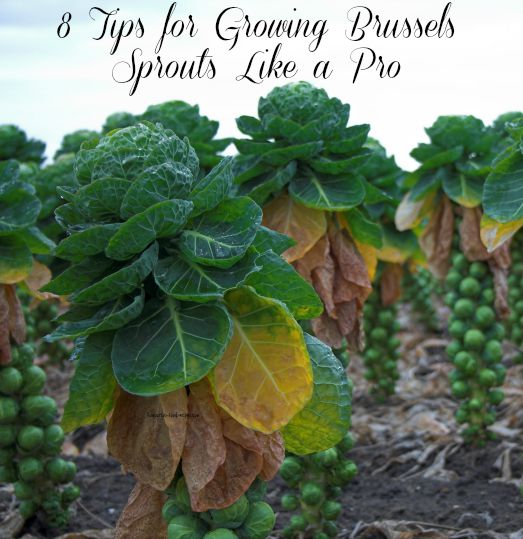8 Tips to Growing Brussels Sprouts like a Pro
Brussels Sprouts is an easy vegetable to grow as long as you are familiar with the growing pattern, soil conditions, and temperature needs. It is a vegetable that is noted for its long growing season and is harvested in the fall. Therefore, plant your Brussels Sprouts in an area of land that you do not expect to clear until the fall. Here are some tips that will have you growing Brussels Sprouts like a pro.
Feel free to Pin This!
- Start Seeds Early– Brussels Sprouts tend to do well if you start the seeds indoors 5-6 weeks before taking them outside and planting them in the garden. Temperatures for growing this vegetable should be in the 45-75 degree range. The seeds should be planted ½ inch deep. Place them in a sunny location so the germination process can be speeded up. Growth should appear in 2-5 days.
- Planting Times– The timing of planting your Brussel Sprouts is important and should be as precise as possible. If you decide to plant from transplants, you should plant them during the months of April to May. On the other hand, if you are planting from seed, you can plant them in the ground from April thru to late June. Remember to take into account the strength of your seedling and weather conditions as you want to plant the healthiest seedlings as possible.
- Prime Soil Conditions– Another thing that will have you growing Brussels Sprouts like a pro is prime soil conditions. This will ensure that you have a good growing season with plenty of yield. The land in which you are going to plant this crop should be tilled to loosen the dirt. If you happen to have some organic compost handy, add it into the soil and it will provide nutrients to the soil. This vegetable grows best when the soil is loose and moist. The soil should be slightly acidic for growing Brussels Sprouts.
- Use Fertilizer– This plant requires a lot of nutrients to produce a higher yield. Therefore, when the plant is just starting to grow, make sure to add some organic compound to the soil. Prime soil conditions means that you will get a higher yield come harvest time. A strong calcium and magnesium based fertilizer will help to produce and maintain a good PH level for growing Brussels Sprouts. It tends to do best in gardens that have a PH level between the 6.0 and 6.5 range. Every month, make sure to feed your Brussels Sprouts crop nitrogen fertilizer for the best crop yield.
- Planting– It is important that each Brussels Sprouts plant is planted deep enough for it to build solid roots. If you happen to have some seedlings that are spindly and weak-looking, bury them into the soil up to the first set of leaves. By doing this, you will enable the plant to build some solid roots. Space the plants 24-30 inches apart when planting them into the ground. Adding organic compost around the plant base every month will feed the plant important nutrients to help it grow properly.
- Watering– Unlike some plants that prefer dry soil conditions, Brussels Sprouts tend to like wet soil. Mind you, this does not mean to soak them every day as this will entice mold and bacteria to grow. Brussels Sprouts like frequent watering, but remember to allow the soil to dry out between watering. The ground should be moist, but not wet.
- Pre-Harvest Preparation- Many vegetables need someone to do pre-harvest prep in order to let the plant know when to stop producing flower buds, Brussels Sprouts is one of them. During the late summer, early fall, you may notice that some of the Brussels Sprouts plant has large developed plant buds as well as underdeveloped ones. In order to help the plant concentrate on the underdeveloped buds, someone has to remove the top part of the plant. Removing the top part of the plant should take place approximately one month before harvest time.
- Harvesting– When harvesting Brussels Sprouts, the plants closest to the base of the plant should be picked first. The leaves should be green and wrapped firmly around the plant bud. These plant buds and leaves should not have worm holes. For those that wish to harvest the plant all at once, simply cut the plant near the plant root once you see that the Brussels Sprouts plant leaves start to turn yellow.
Whether you are planting Brussels Sprouts for the very first time or are a seasoned planter, familiarizing yourself with the plant habits. By learning the characteristics of each plant that you are planting will help to ensure a successful harvest. By following the 8 Tips to Growing Brussels Sprouts like a Pro, you should have a bountiful harvest of Brussels Sprouts each and every year.
To purchase —>Early Sprouting Brussels Sprouts Seeds
If you like this post, see more gardening tips on Pinterest.
Come visit me on Facebook and follow me on Twitter.
Feel free to Pin This!





Leave a Reply